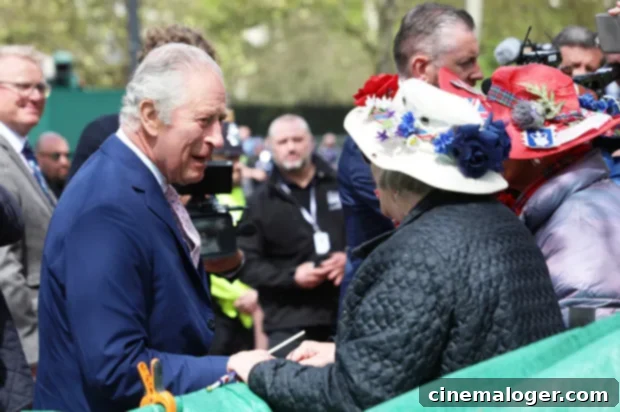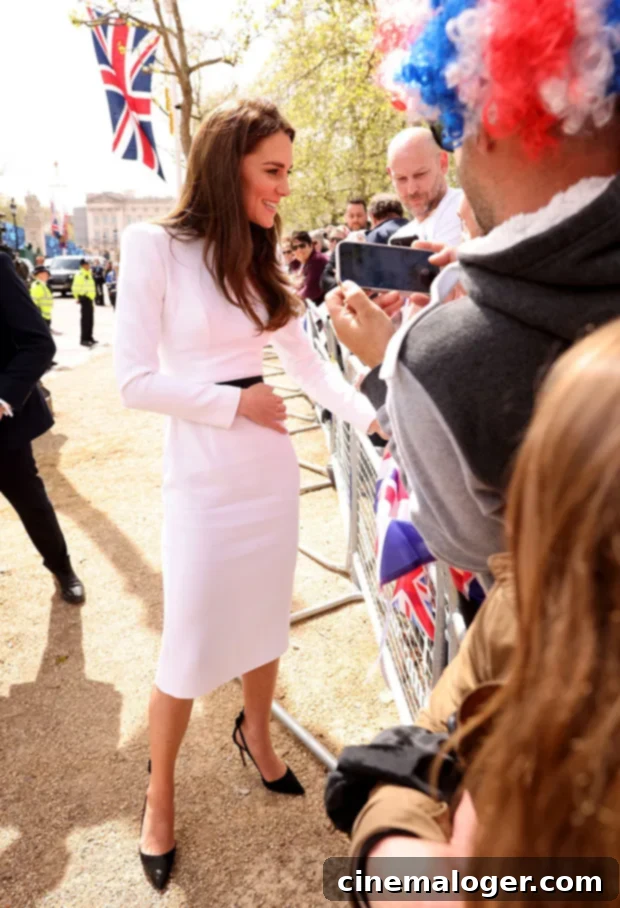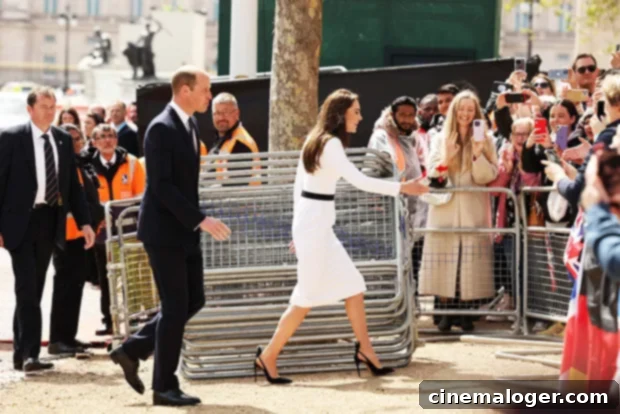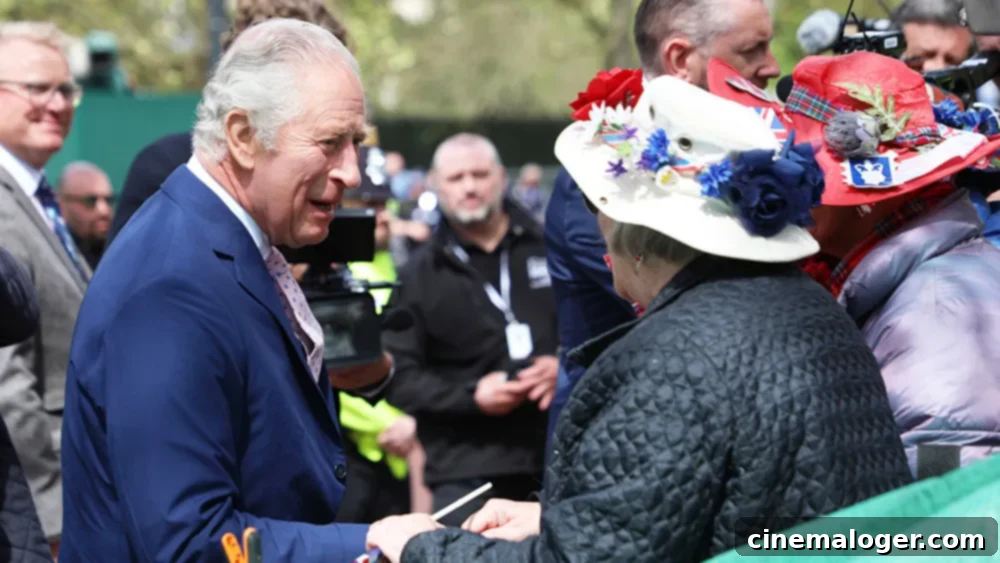King Charles’ Coronation Walkabout: Princess of Wales Shines Amidst Royal Preparations
The air outside Buckingham Palace buzzed with anticipation the day before King Charles III’s historic coronation. Loyal fans and curious tourists alike gathered, hoping for a glimpse of the Royal Family. What they received was an unexpected and delightful surprise: an impromptu walkabout featuring the new monarch, King Charles, alongside the Prince and Princess of Wales, Prince William and Kate Middleton. This spontaneous engagement offered a rare opportunity for the royals to connect directly with the public, setting a warm and approachable tone just hours before the grandeur of the coronation ceremony.
The crowd, stretching along The Mall, erupted in cheers as King Charles, Prince William, and Kate Middleton emerged, their faces beaming with genuine smiles. They graciously spent time shaking hands, exchanging pleasantries, and soaking in the palpable excitement of the well-wishers. For many, this personal interaction was a highlight, a moment to feel truly connected to the unfolding royal history. The Princess of Wales, in particular, was a vision, captivating onlookers with her elegant attire and radiant presence, proving once again her effortless ability to charm and engage with the public.

A Stylish Royal Trio: Fashion Statements Before the Coronation
The royal trio presented a picture of understated elegance during their pre-coronation walkabout. King Charles, in a crisp light blue suit, exuded a calm authority befitting a new sovereign. His son and heir, Prince William, opted for a classic black suit, embodying his steadfast commitment to duty. Both men appeared sharp and composed, ready for the momentous occasion ahead, yet clearly enjoying the informal interaction with the public.
However, it was the Princess of Wales, Kate Middleton, who truly captured attention with her impeccable fashion choice. Stepping out in a stunning white, long-sleeved dress paired with sophisticated black designer heels, Kate solidified her status as a global style icon. Her ensemble was both graceful and modern, a perfect blend of formality and accessibility. The choice of white symbolized purity and new beginnings, a subtle nod to the fresh chapter unfolding for the monarchy under King Charles. Her ability to consistently deliver memorable fashion moments resonates with a wide audience, making her a trendsetter whose style is eagerly observed and admired worldwide.
The Princess’s radiant appearance and her genuine warmth during the walkabout further endeared her to the public. Her presence alongside the King and Prince of Wales underscored her vital role within the modern Royal Family, not just as a supportive spouse but as a key figure in her own right, capable of engaging with and inspiring people. This impromptu appearance highlighted the seamless way she navigates public life, balancing royal tradition with contemporary appeal.
Navigating Royal Dynamics: The Coronation’s Broader Narrative
While the walkabout showcased a united front, the upcoming coronation ceremony was not entirely free from underlying family complexities. The ongoing rift between Prince William and his brother, Prince Harry, has been a subject of intense public and media scrutiny, casting a long shadow over what should be a purely celebratory event. This long-standing tension has become a significant part of the broader narrative surrounding King Charles’s ascension to the throne, illustrating the challenges even royal families face in balancing personal relationships with public duty.
Further adding to this tension was the highly anticipated coronation invitation list. It was ultimately confirmed that Prince Harry would attend the historic event, but his wife, Meghan Markle, the Duchess of Sussex, would not be traveling to the UK. Her decision to remain in California with their two young children, Prince Archie and Princess Lilibet, was widely interpreted as a reflection of the continued distance within the family. While officially citing Archie’s fourth birthday coinciding with the coronation as the reason, the absence of a key royal figure fueled much speculation and discussion about the state of the relationships within the House of Windsor. This narrative of division, despite moments of public unity, remains a compelling backdrop to the historic events unfolding.
The public, keen observers of royal affairs, often scrutinizes these personal dynamics. The absence of Meghan, in particular, underscored the intricate balance between personal desires and public expectations that members of the Royal Family constantly navigate. It serves as a reminder that even amidst the pomp and pageantry of a coronation, the human elements of family relationships persist, sometimes taking precedence over traditional protocol. Despite these underlying narratives, the focus during the walkabout remained firmly on the celebratory spirit, with the royals demonstrating their commitment to their roles and to the British people.

The Next Generation: Children’s Integral Roles in the Coronation
In contrast to the absence of Archie and Lilibet, the three children of the Prince and Princess of Wales – Prince George, Princess Charlotte, and Prince Louis – were expected to play significant and visible roles in the coronation ceremony. Their participation symbolizes the continuity and future of the monarchy, reinforcing the direct line of succession and the enduring legacy of the institution. Their presence adds a touch of youthful exuberance and hope for the future, a poignant reminder of the generations that will carry the royal traditions forward.
According to reports from The Times, the young royals were set to join their parents in a carriage procession, following directly behind King Charles and Queen Camilla during the official ceremony. Prince George, as the second in line to the throne, was particularly singled out for a key role as one of his grandfather’s Pages of Honour. This ceremonial duty involved holding a part of the King’s robe, a significant and highly visible task that placed him at the heart of the historic proceedings. For George, Charlotte, and Louis, this was not merely a family event but a formative experience, immersing them in the ancient rituals and responsibilities that define the British monarchy from an early age.
Their involvement underscores the careful planning and attention to detail that goes into royal events, ensuring that every element, from the youngest participant to the most senior, contributes to the overall narrative of tradition, duty, and succession. The sight of the children participating in such a monumental event is often a source of great delight for the public, offering a glimpse into the future of the monarchy and its enduring appeal across generations.
Prince William’s Pivotal Role: Upholding Centuries of Tradition
Prince William’s role in his father’s coronation was particularly unique and steeped in centuries of tradition, highlighting his direct position as the heir to the throne. Unlike other members of the Royal Family, William was the sole individual designated to pledge loyalty to the new monarch with a special, personal vow. This solemn act, known as the “Homage of Royal Blood,” is a profound moment in the coronation liturgy, emphasizing the deeply personal and hereditary nature of the monarchy.
During this moving part of the ceremony, William knelt before his father, placing his hands between the King’s hands – a symbolic gesture of fealty and trust. He then recited a powerful oath: “I, William, Prince of Wales, pledge my loyalty to you and faith and truth I will bear unto you, as your liege man of life and limb. So help me God.” This declaration is a direct echo of oaths sworn by heirs throughout British history, connecting the modern monarchy to its ancient roots and demonstrating William’s unwavering commitment to his father and the Crown, as detailed in the liturgy of the coronation service.
Beyond this personal pledge, Prince William also played another distinct ceremonial role as the “Stole Robe.” This involved him being part of the Robe Royal service, where he assisted in presenting the magnificent official robe garment to King Charles. This act is not merely a practical function but a deeply symbolic one, signifying William’s support and participation in vesting his father with the sacred symbols of kingship. These specific, elevated roles underscored William’s direct path to the throne and his foundational responsibility within the monarchy, firmly establishing his place as a future king and a key figure in the continuation of the Royal Family’s legacy.

A Coronation of Continuity and Modernity
The pre-coronation walkabout served as a powerful prelude to the historic events that followed, encapsulating both the enduring traditions and the evolving nature of the British monarchy. It highlighted the King’s desire for a more accessible monarchy, seen through his willingness to engage directly with the public, a sentiment echoed by the warmth displayed by the Prince and Princess of Wales. Kate Middleton’s elegant appearance, combined with her approachable demeanor, reinforced her role as a vital asset to the Royal Family, embodying a blend of regal grace and modern sensibility.
Despite the unavoidable undercurrents of family dynamics, the overall focus remained on the monumental significance of King Charles’s coronation. The careful inclusion of the youngest royals, Prince George, Princess Charlotte, and Prince Louis, in key ceremonial roles underscored the themes of continuity and the future of the Crown. Prince William’s solemn and deeply traditional duties, particularly the Homage of Royal Blood, powerfully articulated his commitment as heir and the sacred responsibilities he will one day assume. These moments, both spontaneous and ceremonial, painted a vivid picture of a monarchy striving to balance its ancient heritage with the demands and expectations of a contemporary world, all while generating immense public interest and anticipation for a truly historic occasion.
